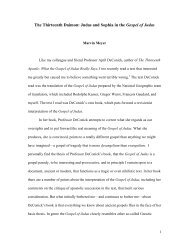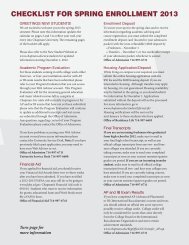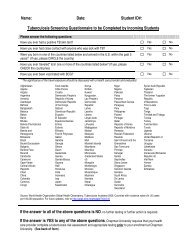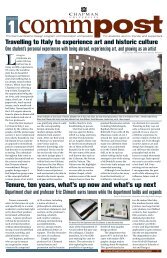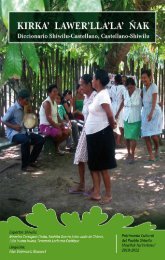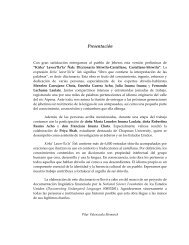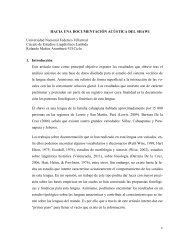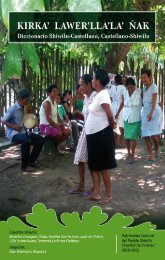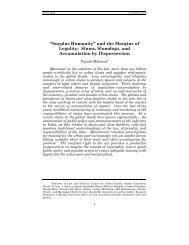WILKINSON COLLEGE MAGAZINE also - Chapman University
WILKINSON COLLEGE MAGAZINE also - Chapman University
WILKINSON COLLEGE MAGAZINE also - Chapman University
Create successful ePaper yourself
Turn your PDF publications into a flip-book with our unique Google optimized e-Paper software.
A brush fire rapidly approaches houses below.<br />
high fire-risk areas would have to be certified by local fire<br />
authorities to verify that adequate protection will be<br />
available. Finally, local governments would be prohibited<br />
from approving dead-end subdivisions which lack<br />
alternative fire and evacuation routes. Not surprisingly,<br />
both bills are opposed by the California Chamber of<br />
Commerce and local governments, and supported by<br />
firefighters’ unions and the Sierra Club.<br />
Designing policy solutions that the public will embrace<br />
can be a challenge partly because of public attitudes<br />
toward risk. Social psychologists have documented the<br />
tendency of experts, policymakers and the mass public to<br />
think about risk differently. Experts focus on the<br />
quantitative aspects, such as the probability that an event<br />
will occur and the number of injuries and deaths, while<br />
the layperson is just as likely to consider qualitative<br />
aspects, including past experiences, intuition and their<br />
own ability to control the hazard. Policymakers may rely<br />
upon the best scientific information available, but their<br />
solutions might not be accepted if residents consistently<br />
underestimate wildfire risk.<br />
The capacity for government to deal with future wildfires<br />
effectively depends upon institutional legitimacy, that is,<br />
popular support for public policies to reduce wildfire risk.<br />
Our survey of Orange and San Diego County residents<br />
conducted after the wildfires identified some of the<br />
psychological factors that explain whether people support<br />
proposed government regulations to reduce wildfires.<br />
Volume 1 Number 2 • Fall/Winter 2008<br />
THOUGHTS: Preparing for the<br />
Next Big Burn<br />
Chief among these factors is risk perception. Some<br />
residents are inclined see wildfires as inevitable as<br />
opposed to others who are more likely to see wildfires as<br />
not inevitable at all, but rather the result of poor public<br />
decisions. Those who see wildfires as exacerbated by<br />
poor public decisions are <strong>also</strong> more likely to see them as<br />
manageable. Another factor influencing support for<br />
public policies is trust. Overall, social trust is on the<br />
decline, with successive generations of Americans less<br />
likely to consider others “trustworthy.” This has<br />
implications for public problems such as fire risk<br />
mitigation because people favor public spending on a<br />
policy problem when trust in government is high.<br />
Individuals tend to favor government intervention if they<br />
perceive the risk as “public,” meaning that the actions of<br />
others contribute to the severity of the risk.<br />
The question of trust has implications for wildfire<br />
management because political trust is related to the<br />
willingness of residents to accept government action to<br />
solve public problems. Research by the U.S. Forest<br />
Service has found that individuals with lower levels of<br />
knowledge rely more upon trust when judging wildfire<br />
risks and the benefits of fire prevention strategies. Since<br />
these low-information voters have as much say as those<br />
with higher levels of knowledge, it is as important for<br />
government officials to build trust as it is to educate<br />
residents about wildfire risk.<br />
Residents with high levels of trust are more likely to agree<br />
that government should engage in all types of policies to<br />
reduce fire risk. These residents are more likely to agree<br />
with a variety of policy alternatives, including education,<br />
improving land management, fireproofing requirements,<br />
restrictive building codes, more restrictive zoning,<br />
tougher fire safety laws, investments in firefighting<br />
equipment, preventative burning and encouraging<br />
property owners to take more responsibility for<br />
fire prevention.<br />
One interesting pattern is that ethnic communities within<br />
Southern California showed different levels of trust.<br />
Asians displayed the highest level of political trust.<br />
Whites showed a significantly lower level of trust than<br />
did Asians, and Hispanic residents had a slightly lower<br />
level of trust than Whites (too few African Americans<br />
appeared in the sample for us to make generalizations).<br />
These differences add support to the notion that there are<br />
communities within communities where policymakers<br />
should concentrate their efforts to build support for<br />
various fire management strategies.<br />
<strong>WILKINSON</strong> REVIEW<br />
5




